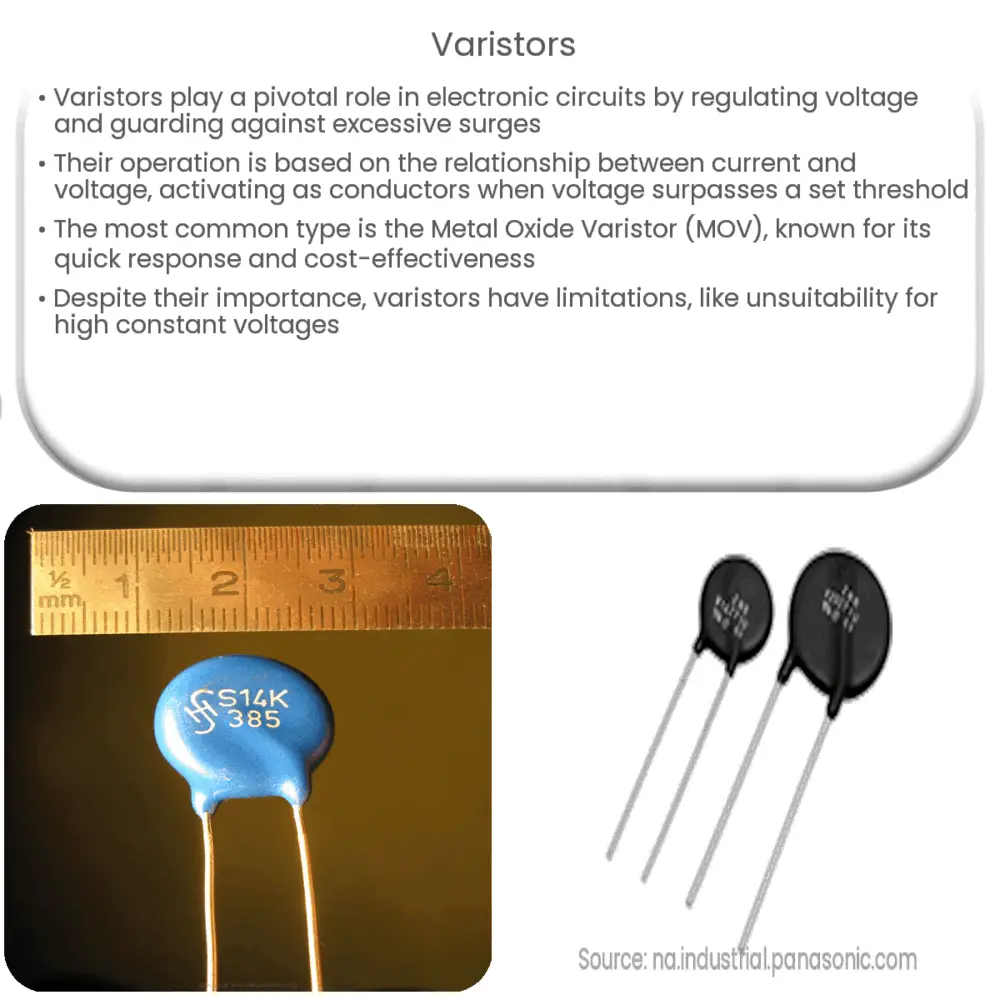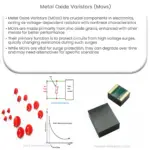Explore the role, working principle, types, applications, and limitations of varistors in electronic circuits protection.

Understanding Varistors
Varistors are crucial components in electronic circuits that play a significant role in voltage regulation. They are engineered to control unwanted voltage surges and protect sensitive electronic equipment from damage due to excessive voltage. Their name, varistor, is derived from Variable Resistor, signifying its key function in a circuit.
Working Principle
The fundamental operating principle of varistors is based on the relationship between current and voltage. At normal voltage levels, a varistor behaves like an insulator, allowing minimal current to pass through. However, when voltage surpasses a certain threshold, the varistor transforms into a conductor, permitting an increased amount of current to pass, thereby preventing voltage spikes in the circuit.
Types of Varistors
- Metal Oxide Varistors (MOVs)
Metal Oxide Varistors, often abbreviated as MOVs, are the most commonly used type of varistors. Their main ingredient is zinc oxide, mixed with other metal oxides such as bismuth, cobalt, and manganese, which are compacted and heated to form a ceramic-like material. These are recognized for their high-energy absorption capability, quick response time to transient voltages, and cost-effectiveness.
- Silicon Carbide Varistors
Before the advent of MOVs, Silicon Carbide Varistors were the primary type used in electronic circuits. Although they have been largely replaced by MOVs due to the latter’s superior performance, Silicon Carbide Varistors still find usage in specialized applications due to their high power handling capability.
Applications of Varistors
- Surge Protection: Varistors are employed in surge protection devices to regulate voltage levels and prevent damage to the electronic equipment due to power surges or lightning strikes.
- RFI/EMI Filtering: In certain applications, varistors are used to filter out Radio Frequency Interference (RFI) or Electromagnetic Interference (EMI).
- Power Supply Units: Varistors are used in power supply units of various electronic devices to prevent voltage spikes and ensure steady power delivery.
- Automotive Electronics: In the automotive industry, varistors protect sensitive electronics and microprocessors from voltage fluctuations.
Varistor Specifications
There are several key specifications when dealing with varistors. These include the maximum allowed voltage (also known as clamping voltage), energy absorption capabilities (measured in Joules), response time, and the varistor’s voltage rating at a specific current level.
Selection and Usage of Varistors
Choosing the correct varistor for an application is a crucial task. Varistors should be chosen based on the maximum operating voltage of the circuit, the energy of the potential surge, and the desired response time. Once chosen, the varistor is usually placed in parallel with the circuit component it is meant to protect. This ensures that in case of a voltage surge, the varistor will quickly activate and absorb the excess voltage, thus protecting the component.
Limitations of Varistors
Despite their advantages, varistors do have certain limitations. For example, they are not suitable for circuits with continually high voltages since the varistor’s heat dissipation could lead to failure. Moreover, a varistor cannot limit the current flowing through the circuit, which could be an issue in certain applications.
Conclusion
In conclusion, varistors are essential components in many electronic systems, providing crucial protection against voltage surges. They work by transforming from insulators to conductors when a specific voltage threshold is surpassed, thus preventing potential damage to electronic components. Despite their limitations, their cost-effectiveness, versatility, and simple implementation make them an invaluable tool in electronics. As technology continues to advance, varistors’ importance in protecting sensitive electronic components and systems from voltage spikes is more relevant than ever.



